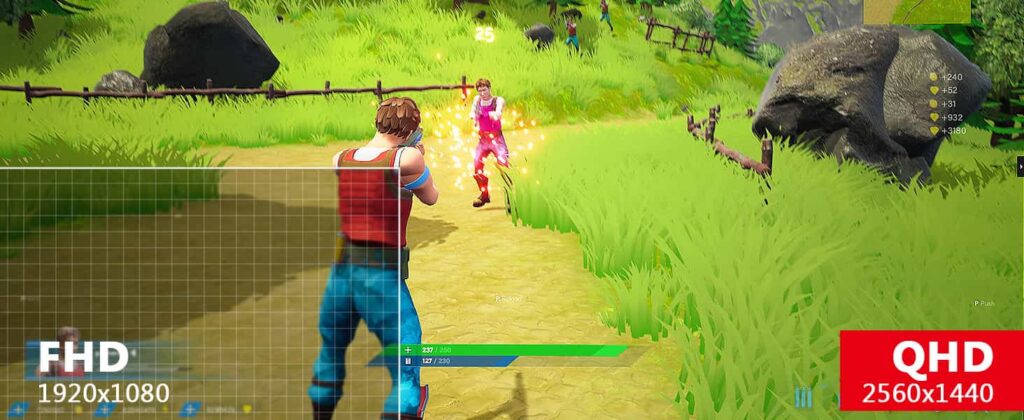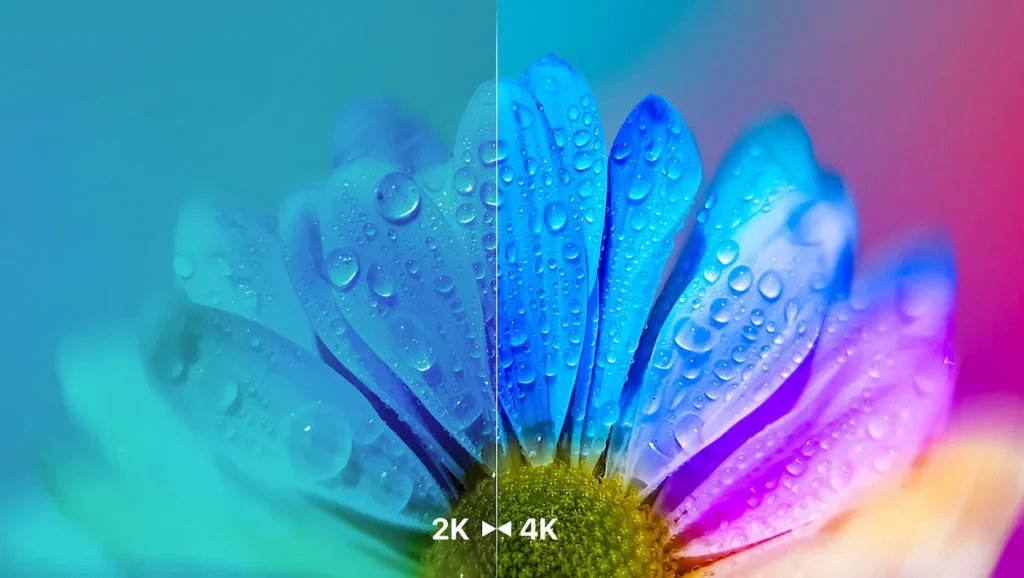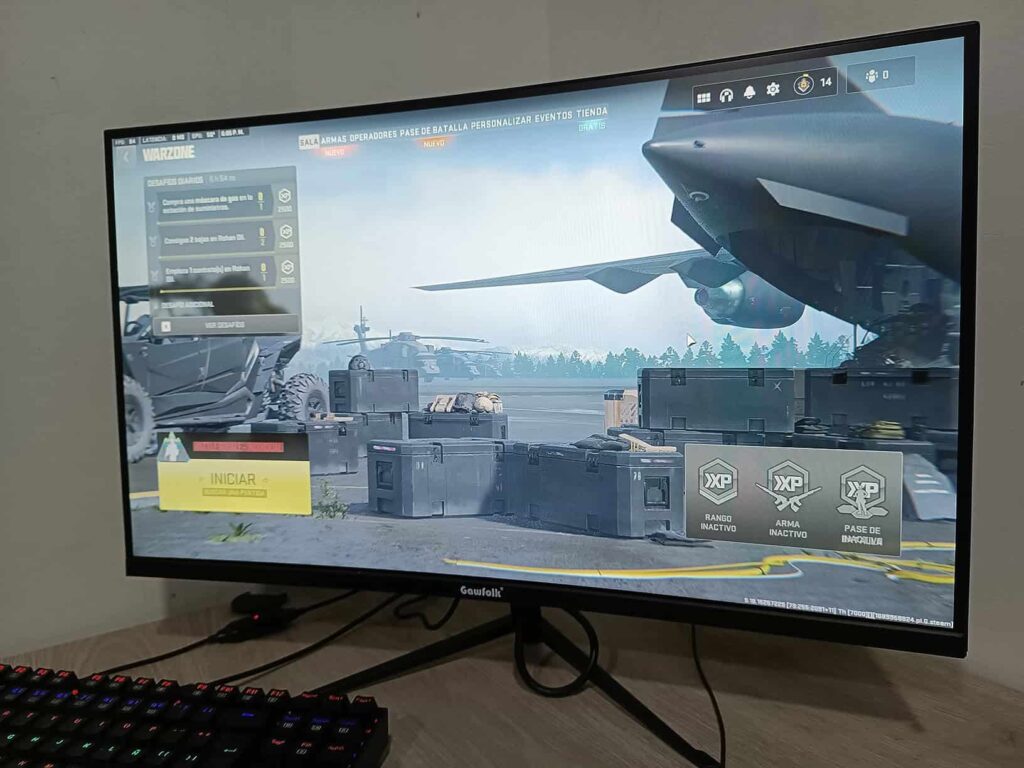We’ve tested a lot of monitors over the years, from entry-level displays that quietly impress to high-end panels that bring out every detail you never knew was there. It doesn’t matter if you are getting into gaming for the first time or just looking to upgrade from your old 1080p panel, the question of “what is 2K resolution?” comes up often enough that it’s worth clearing up in one place. It might sound like a simple marketing term, but it actually has a real impact on how your games and desktop feel day-to-day.
Understanding 2K Resolution
Let’s get this out of the way first. Technically, 2K means a horizontal resolution of around 2,000 pixels, which is 2048 x 1080 in cinema terms. On monitors, what people call “2K” is actually 2560 x 1440, also known as 1440p or QHD. It’s one of those quirks that stuck around in the monitor space, and it’s what you get on most gaming monitors marketed as “2K”.
![]()
The extra pixels over 1080p give you a noticeably sharper image. You will see finer details in textures, text looks crisper, and your overall experience on the desktop improves because everything just looks that bit cleaner. It’s especially useful if you play games that rely on spotting small details at a distance, like PUBG or Warzone, or if you spend time editing photos or videos and need a bit more screen real estate.
2K vs 1080p
Moving from 1080p (1920 x 1080) to 2K (2560 x 1440) is one of the most noticeable jumps you can make. The pixel count goes up by about 77%, giving you more working space on your desktop and sharper visuals in your games. It’s something you will see immediately the first time you boot up your PC with a 1440p monitor connected.

In games, you will notice that aliasing (jagged edges) is reduced even before turning on anti-aliasing settings, and small objects in the distance become easier to see clearly. If you have been gaming on 1080p for years, 2K is a sweet spot upgrade that doesn’t completely overwhelm your GPU the way 4K might, while still giving you a more premium look in everything you do.
2K vs 1440p
You might have seen monitors listed as both 2K and 1440p and wondered if there is a difference. The short answer is there isn’t. 2K in the gaming monitor space means 2560 x 1440, which is 1440p. There is no technical difference between them when you’re shopping for a gaming monitor, so if you see “2K” on the box, it’s the same resolution as “1440p.”
It’s an ideal resolution for 27” monitors, where the pixel density is high enough that text and images appear sharp, but you don’t need to use any scaling in Windows. You get more space for windows and applications, which makes it easier to multitask, and your games benefit from a sharper, clearer look compared to 1080p.
2K vs 4K
When considering your next monitor upgrade, you might be weighing up 2K against 4K. 4K gives you a resolution of 3840 x 2160, which is four times the pixel count of 1080p and significantly higher than 2K. The benefit of 4K is clear: an incredibly sharp image, especially on larger screens, and the ability to see details in games and movies that you simply don’t get with lower resolutions.

However, the downside is that 4K puts a heavy load on your GPU, and maintaining high frame rates in demanding games becomes much harder unless you have a top-end graphics card. Even then, you might need to reduce settings to keep gameplay smooth.
2K offers a strong middle ground. You get a clear step up from 1080p while still being able to take advantage of high refresh rates like 144Hz, 165Hz, or higher, without the same performance hit you would face with 4K. For many gamers, 2K is the right choice because it balances image clarity with performance, letting you enjoy the benefits of a sharper image without compromising smooth gameplay.
Is 2K Good for Gaming?
For gaming, 2K hits a sweet spot. It allows you to enjoy sharper visuals than 1080p while keeping your frame rates high, which is important for competitive gaming. Many monitors in this range support refresh rates of 144Hz, 165Hz, or even 240Hz, letting you pair higher resolution with smooth gameplay for a better overall experience.

Whether you’re playing fast-paced shooters like Valorant, racing games, or single-player open-world titles, the boost in clarity you get from 2K helps make your games look and feel more detailed. You will notice distant enemies and environmental details more easily, which can even help in competitive scenarios.
Most modern GPUs handle 2K gaming comfortably, making it a practical upgrade if you want better visuals without having to drop down settings too much to maintain high frame rates.
Benefits of 2K Resolution
• Noticeable improvement in image clarity and sharpness over 1080p
• Allows high refresh rate gaming while keeping frame rates smooth
• Great for 27” monitors without the need for scaling
• Provides more desktop space for productivity and multitasking
• Makes games look more detailed, enhancing immersion
• Suitable for both gaming and creative work like photo editing
It’s a resolution that feels like a genuine upgrade without the heavy system demands of 4K, giving you a more premium experience in day-to-day use and gaming.
Downsides of 2K Resolution
While 2K is easier to run than 4K, it still requires more GPU power than 1080p. Depending on your hardware, you may need to lower some settings in very demanding games to keep high frame rates, particularly if you are aiming for 165Hz or higher.
Another consideration is that the jump from 2K to 4K isn’t as visually dramatic as going from 1080p to 2K, so if you’re planning on upgrading to 4K later, it might feel like a smaller step forward.
However, for most users, these downsides are minor compared to the benefits you get from the upgrade.
Who Should Choose 2K Resolution?
If you’re looking to get more out of your gaming setup with a sharper image and smoother gameplay, 2K is a strong choice. It’s ideal for gamers who play a variety of genres, from competitive shooters to single-player story games, and want a balance between visuals and performance.

It’s also a good fit for those who work from their PC and want more space for applications and productivity tasks while keeping everything looking clear and sharp. If you’re upgrading from a 1080p monitor, 2K will feel like a meaningful improvement without putting unnecessary strain on your GPU.
For anyone using a 27” monitor, 2K is arguably the ideal resolution, making everything from gaming to browsing look better while keeping your system performing well.
Final Thoughts
2K resolution is a practical upgrade for gamers and general users looking to get more from their monitors. It strikes a strong balance between visual clarity and system performance, making it suitable for a wide range of uses, from gaming to content creation and productivity.
If you want a monitor that delivers a clear, detailed image without the heavy demands of 4K, while still letting you enjoy high refresh rates for smoother gameplay, 2K is a choice you won’t regret. It’s a step forward that feels immediately noticeable, making your games and day-to-day tasks look cleaner and sharper without compromising the smoothness you need for a great experience.
FAQs
Is 2K the same as 1440p?
Yes, in the gaming monitor market, 2K and 1440p both refer to 2560 x 1440 resolution.
Does 2K resolution look noticeably better than 1080p?
Yes, it offers sharper visuals, reduced aliasing, and more screen space for multitasking.
Do I need a high-end GPU for 2K gaming?
You will need a stronger GPU than for 1080p, but most mid-range cards handle 2K gaming well, especially if you play at high settings.
Is 2K resolution good for competitive gaming?
Yes, it offers a clearer image while still allowing high refresh rate gaming, which is valuable for fast-paced games.
What monitor size is best for 2K resolution?
27” is widely considered the sweet spot for 2K, providing sharp visuals without needing scaling.
References
- https://en.wikipedia.org/wiki/2K_resolution
- https://www.lenovo.com/gb/en/faqs/pc-life-faqs/what-is-2k-resolution/?orgRef=https%253A%252F%252Fwww.google.com%252F&srsltid=AfmBOopa8PfQcSW0Gznw9uQKybaiulqzcN5JoD8TnyQnb5HFuo-kOp-X
- https://www.benq.com/en-me/knowledge-center/knowledge/what-is-resolution-of-monitor-full-hd-vs-2k-vs-4k.html